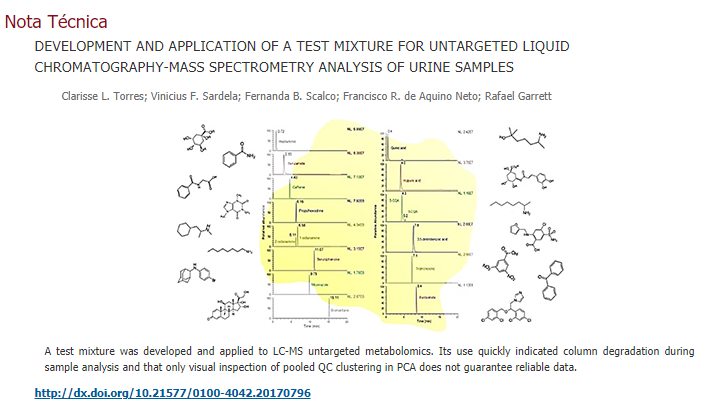Sexta-feira pede artigo novo, não é mesmo? Que tal dois artigos do Laboratório de Metabolômica (LabMeta) quentinhos para animar seu final de semana.

No estudo, uma mistura teste foi utilizada para avaliação do desempenho de um cromatógrafo líquido acoplado à espectrômetro de massas frente a uma análise metabolômica não direcionada. Os resultados podem ajudar na elaboração de estratégias e controle de qualidade nas abordagens metabolômicas não direcionadas, obtendo dados de alta qualidade. O artigo foi publicado online no site da revista Química Nova com o título “Development and Application of a Test Mixture for Untargeted Liquid Chromatography-Mass Spectrometry Analysis of Urine Samples“
Abstract
Metabolic profiling of complex biological matrices based on liquid chromatography-mass spectrometry (LC-MS) allows detecting a wide range of metabolites with distinct concentrations and physicochemical properties. Given the complexity of samples and the necessity of a comprehensive approach in untargeted metabolomics, quality control strategies are mandatory to obtain high-quality data. The LC-MS performance must be monitored and evaluated to guarantee data reliability. In this study, a test mixture (TM) was developed, systematically evaluated, and applied to untargeted metabolomics of urine samples from individuals suspected of inborn errors of metabolism. The TM was composed of fifteen analytes that eluted across the entire gradient in reversed-phase columns and ionized in positive/negative electrospray modes. It helped set the LC-MS conditions for urine analysis, from sample reconstitution solvent to selecting the MS ion source parameters. The TM quickly indicated column stationary phase degradation during the batch analysis when employed to monitor and evaluate the LC-MS system in an untargeted metabolomic analysis. Thus, in addition to pooled QC samples, a TM can be employed in untargeted metabolomics to rapidly assess the system performance avoiding unnecessary efforts for further data treatment and multivariate analysis of poor quality data.
Você encontra o artigo clicando aqui.
***
O segundo é uma colaboração entre laboratórios do IQ que o LabMeta atuou como colaborador. Nesse artigo foi investigado a ação anti-corrosiva do extrato aquoso do aula do Joazeiro, uma árvore da região semi-árida do Brasil. O extrato possui um grande potencial de possuir inibidores de corrossão, possivelmente graças a moléculas de saponina, os cálculos quanticos mostraram que ela possui um papel importante no processo de doação de elétrons. O artigo foi publicado na revista Processes com o título “Ziziphus joazeiro Stem Bark Extract as a Green Corrosion
Inhibitor for Mild Steel in Acid Medium”
Abstract
The aqueous extract of Joazeiro stem bark (EJSB) and its high molecular weight fraction (HMWF) were examined as potential corrosion inhibitors of mild steel in 1 mol L-1 hydrochloric acid media, using weight-loss measurements, potentiodynamic polarization curves and an electrochemical impedance spectroscopy (EIS).Varying the concentration of the inhibitors from 100 to 800 mg L-1, the results show an increase in anticorrosive efficiency from 85.4 to 89.8 and 89.8 to 93.0% for EJSB and its HMWF, respectively, using the data of the gravimetric essay, and from 84.5 to 94.5 and 89.9 to 94.7% for EJSB and its HMWF, respectively, from the impedance data. The composition of the crude extract was chemically characterized by liquid chromatography-high resolution mass spectrometry. Additionally, scanning electron microscopy (SEM) and X-ray photoelectron spectroscopy (XPS) were used, respectively, to morphologically and chemically characterize the surface. Considering that the saponin molecules, the main constituent from juá, are responsible for its inhibitory action, quantum chemical calculations showed that the C67, C69 and O144 atoms likely have an important role in the process of electron-donation of saponin to metal, due to the higher values of ƒk+ and %HOMO observed on these atoms.
Você encontra o artigo clicando aqui.

